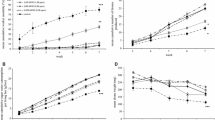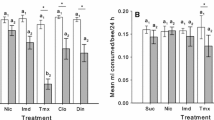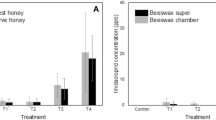Abstract
Bombus terrestris bumblebees are important pollinators of wild flowers, and in modern agriculture they are used to guarantee pollination of vegetables and fruits. In the field it is likely that worker bees are exposed to pesticides during foraging. To date, several tests exist to assess lethal and sublethal side-effects of pesticides on bee survival, growth/development and reproduction. Within the context of ecotoxicology and insect physiology, we report the development of a new bioassay to assess the impact of sublethal concentrations on the bumblebee foraging behavior under laboratory conditions. In brief, the experimental setup of this behavior test consists of two artificial nests connected with a tube of about 20 cm and use of queenless micro-colonies of 5 workers. In one nest the worker bees constructed brood, and in the other food (sugar and pollen) was provided. Before exposure, the worker bees were allowed a training to forage for untreated food; afterwards this was replaced by treated food. Using this setup we investigated the effects of sublethal concentrations of the neonicotinoid insecticide imidacloprid, known to negatively affect the foraging behavior of bees. For comparison within the family of neonicotinoid insecticides, we also tested different concentrations of two other neonicotinoids: thiamethoxam and thiacloprid, in the laboratory with the new bioassay. Finally to evaluate the new bioassay, we also tested sublethal concentrations of imidacloprid in the greenhouse with use of queenright colonies of B. terrestris, and here worker bees needed to forage/fly for food that was placed at a distance of 3 m from their hives. In general, the experiments showed that concentrations that may be considered safe for bumblebees can have a negative influence on their foraging behavior. Therefore it is recommended that behavior tests should be included in risk assessment tests for highly toxic pesticides because impairment of the foraging behavior can result in a decreased pollination, lower reproduction and finally in colony mortality due to a lack of food.

Similar content being viewed by others
References
Armengaud C, Causse N, Ait-Oubah J et al (2000) Functional cytochrome oxidase histochemistry in the honeybee brain. Brain Res 859:390–393
Bonmatin JM, Moineau I, Charvet R et al (2003) A LC/APCI-MS/MS method for analysis of imidacloprid in soils, in plants, and in pollens. Anal Chem 75:2027–2033
Bortolotti L, Montanari R, Marcelino J et al (2003) Effects of sub-lethal imidacloprid doses on the homing rate and foraging activity of honey bees. Bull Insectol 56:63–67
Brunet JL, Badiou A, Belzunces LP (2005) In vivo metabolic fate of [C-14]-acetamiprid in six biological compartments of the honeybee, Apis mellifera L. Pest Manag Sci 61:742–748
Chauzat MP, Faucon JP, Martel AC et al (2006) A survey of pesticide residues in pollen loads collected by honey bees in France. J Econ Entomol 99:253–262
Colin ME, Le Conte Y, Vermandere JP (2001) Managing nuclei in insect-proof tunnel as an observation tool for foraging bees: sublethal effects of deltamethrin and imidacloprid. In: Belzunces LP, Pélissier C, Lewis GB (eds) Hazards of pesticides to bees. INRA, Paris, pp 259–268
Decourtye A, Lacassie E, Pham-Delegue MH (2003) Learning performances of honeybees (Apis mellifera L.) are differentially affected by imidacloprid according to the season. Pest Manag Sci 59:269–278
Decourtye A, Armengaud C, Renou M et al (2004a) Imidacloprid impairs memory and brain metabolism in the honeybee (Apis mellifera L.). Pestic Biochem Physiol 78:83–92
Decourtye A, Devillers J, Cluzeau S et al (2004b) Effects of imidacloprid and deltamethrin on associative learning in honeybees under semi-field and laboratory conditions. Ecotoxicol Environ Saf 57:410–419
Decourtye A, Devillers J, Genecque E et al (2005) Comparative sublethal toxicity of nine pesticides on olfactory learning performances of the honeybee Apis mellifera. Arch Environ Contam Toxicol 48:242–250
Desneux N, Decourtye A, Delpuech JM (2007) The sublethal effects of pesticides on beneficial arthropods. Annu Rev Entomol 52:81–106
El Hassani AK, Dacher M, Garry V et al (2008) Effects of sublethal doses of acetamiprid and thiamethoxam on the behavior of the honeybee (Apis mellifera). Arch Environ Contam Toxicol 54:653–661
EPPO (2001) Standards PP1/170. Test methods for evaluating the side effects of plant protection products on honeybees. Bull OEPP/EPPO 31:323–330
Guez D, Belzunces LP, Maleszka R (2003) Effects of imidacloprid metabolites on habituation in honeybees suggest the existence of two subtypes of nicotinic receptors differentially expressed during adult development. Pharmacol Biochem Behav 75:217–222
Iwasa T, Motoyama N, Ambrose JT et al (2004) Mechanism for the differential toxicity of neonicotinoid insecticides in the honey bee, Apis mellifera. Crop Prot 23:371–378
Jones AK, Raymond-Delpech V, Thany SH et al (2006) The nicotinic acetylcholine receptor gene family of the honey bee, Apis mellifera. Genome Res 16:1422–1430
Lambin M, Armengaud C, Raymond S et al (2001) Imidacloprid-induced facilitation of the proboscis extension reflex habituation in the honeybee. Arch Insect Biochem Physiol 48:129–134
Miranda CRE, Bitondi MMG, Simoes ZLP (2003) Effect of proctolin on the egg-laying activity of Apis mellifera queens. J Apic Res 42(3):35–38
Mommaerts V, Sterk G, Smagghe G (2006) Bumblebees can be used in combination with juvenile hormone analogues and ecdysone agonists. Ecotoxicology 15:513–521
Morandin LA, Winston ML (2003) Effects of novel pesticides on bumble bee (Hymenoptera : Apidae) colony health and foraging ability. Environ Entomol 32:555–563
Nauen R, Ebbinghaus-Kintscher U, Schmuck R (2001) Toxicity and nicotinic acetylcholine receptor interaction of imidacloprid and its metabolites in Apis mellifera (Hymenoptera : Apidae). Pest Manag Sci 57:577–586
Nauen R, Ebbinghaus-Kintscher U, Salgado VL et al (2003) Thiamethoxam is a neonicotinoid precursor converted to clothianidin in insects and plants. Pestic Biochem Physiol 76:55–69
Ramirez-Romero R, Chaufaux J, Pham-Delegue MH (2005) Effects of Cry1Ab protoxin, deltamethrin and imidacloprid on the foraging activity and the learning performances of the honeybee Apis mellifera, a comparative approach. Apidologie 36:601–611
Schmidt HW (1996) The reaction of bees under the influence of the insecticide imidacloprid, Proc 6th Int Symp on Hazards of Pesticides to Bees, Braunschweig (Germany), Appendix 12
Schmuck R (1999) No causal relationship between Gaucho seed dressing in sunflowers and the French bee syndrome. Pflanzenschutz Nachrichten Bayer 52:257–299
Schmuck R, Schoning R, Stork A, Schramel O et al (2001) Risk posed to honeybees (Apis mellifera L. Hymenoptera) by an imidacloprid seed dressing of sunflowers. Pest Manag Sci 57:225–238
Suchail S, Guez D, Belzunces LP (2000) Characteristics of imidacloprid toxicity in two Apis mellifera subspecies. Environ Toxicol Chem 19:1901–1905
Suchail S, Guez D, Belzunces LP (2001) Discrepancy between acute and chronic toxicity induced by imidacloprid and its metabolites in Apis mellifera. Environ Toxicol Chem 20:2482–2486
Suchail S, De Sousa G, Rahmani R et al (2004a) In vivo distribution and metabolisation of C-14-imidacloprid in different compartments of Apis mellifera L. Pest Manag Sci 60:1056–1062
Suchail S, Debrauwer L, Belzunces LP (2004b) Metabolism of imidacloprid in Apis mellifera. Pest Manag Sci 60:291–296
Tan J, Galligan JJ, Hollingworth RM (2007) Agonist actions of neonicotinoids on nicotinic acetylcholine receptors expressed by cockroach neurons. Neurotoxicology 28:829–842
Tasei JN (2002) Impact of agrochemicals on non-Apis bees. In: Devillers J, Pham-Delègue M (eds) Honey bees: estimating the environmental impact of chemicals. Taylor and Francis, London, pp 101–131
Tasei JN, Lerin J, Ripault G (2000) Sub-lethal effects of imidacloprid on bumblebees, Bombus terrestris (Hymenoptera: Apidae), during a laboratory feeding test. Pest Manag Sci 56:784–788
Thompson H (2003) Behavioural effects of pesticides in bees—their potential for use in risk assessment. Ecotoxicology 12:317–330
Van der Steen JM (2001) Review of the methods to determine the hazard and toxicity of pesticides to bumblebees. Apidologie 32:399–406
Vandame R, Meled M, Colin ME et al (1995) Alteration of the homing flight in the honey bee Apis mellifera L. exposed to sublethal dose of deltamethrin. Environ Toxicol Chem 14:855–860
Wolf S, Moritz RFA (2008) Foraging distance in Bombus terrestris L. (Hymenoptera : Apidae). Apidologie 39:419–427
Yang EC, Chuang YC, Cheng YL et al (2008) Abnormal foraging behavior induced by sublethal dosage of imidacloprid in the honey bee (Hymenoptera: Apidae). J Econ Entomol 101:1743–1748
Acknowledgments
The authors are indebted to Kris Jans (Biobest) for his help during the experiments, and to Dr. Helen Thompson (CSL, York, UK) for her careful editing. This research project was supported in part by the Research Council of VUB (Brussels, Belgium) and the Fonds National de la Recherche Luxemborg (FNR) (Luxembourg).
Author information
Authors and Affiliations
Corresponding authors
Rights and permissions
About this article
Cite this article
Mommaerts, V., Reynders, S., Boulet, J. et al. Risk assessment for side-effects of neonicotinoids against bumblebees with and without impairing foraging behavior. Ecotoxicology 19, 207–215 (2010). https://doi.org/10.1007/s10646-009-0406-2
Received:
Accepted:
Published:
Issue Date:
DOI: https://doi.org/10.1007/s10646-009-0406-2




